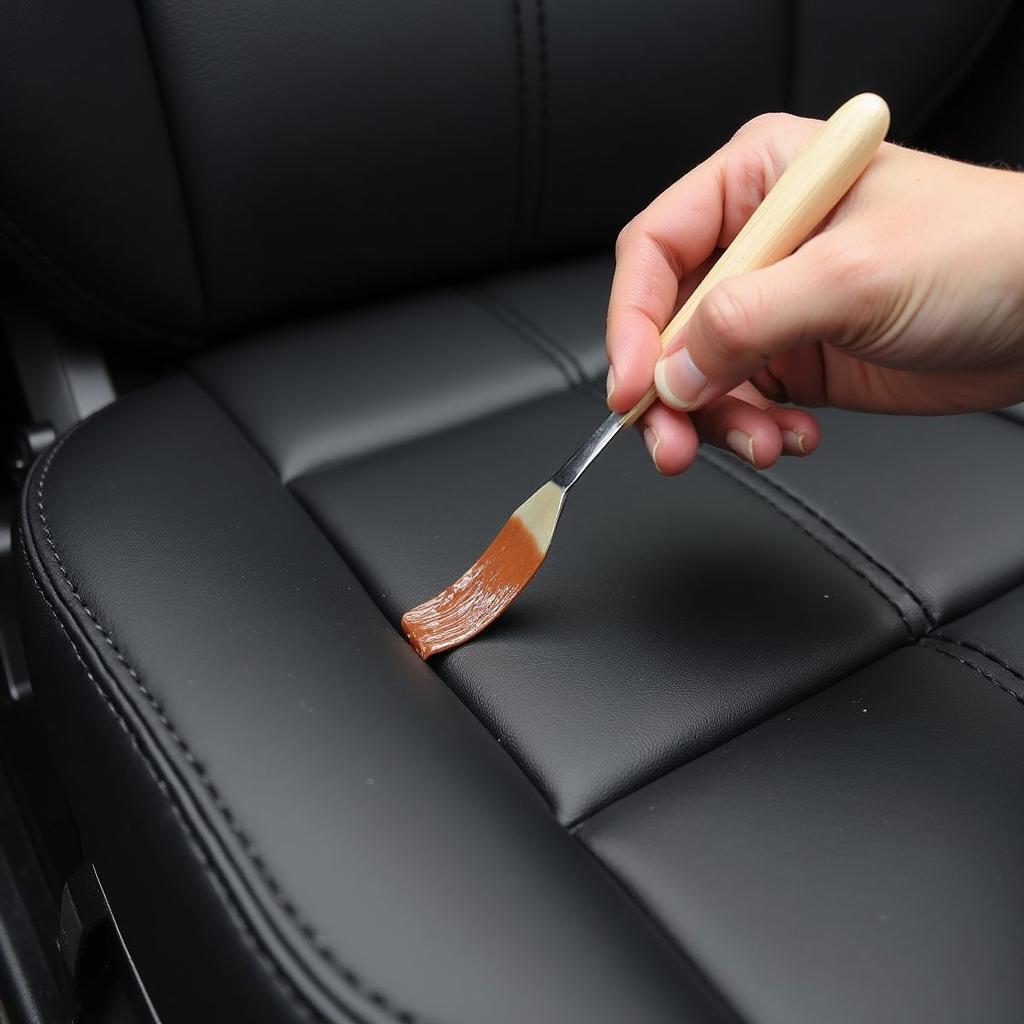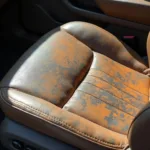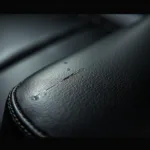A tear in your car seat can be an eyesore and detract from the overall aesthetic of your vehicle’s interior. But beyond the cosmetic impact, a torn car seat can also compromise safety and comfort while driving. Thankfully, you don’t always need a professional to fix it. This guide will explore various DIY methods for how to repair a tear in a car seat, helping you save money and restore your car’s interior to its former glory.
Assessing the Damage: What Type of Tear Are You Dealing With?
Before diving into the repair process, it’s crucial to assess the extent of the damage. Different repair solutions are suitable for different types of tears.
- Small Cuts and Punctures: These can often be addressed with simple patching techniques using adhesive patches or liquid leather vinyl repair kits.
- Larger Tears and Rips: These usually require more involved techniques like sewing or using a specialized patching kit designed for larger areas.
- Tears on Seams: These can be tricky as they involve structural damage. While minor seam tears can sometimes be repaired with strong thread and a curved needle, larger tears might require professional attention.
Gathering Your Supplies: What You’ll Need to Fix That Tear
Having the right tools and materials on hand can make your car seat repair process smoother and more successful. Here are some essential items you’ll likely need:
- Cleaning Supplies: A gentle cleaner, microfiber cloths, rubbing alcohol (for leather)
- Repair Materials: Depending on your chosen method, you’ll need either a patching kit, liquid leather vinyl repair, or strong thread and a curved needle.
- Tools: Scissors, measuring tape, pen or marker, masking tape, tweezers (for small patches)
DIY Repair Methods: Your Options for Fixing That Annoying Tear
Now, let’s delve into the different methods you can use to repair a tear in your car seat:
1. Patching: A Quick Fix for Small to Medium Tears
Patching is a popular method for repairing small to medium-sized tears, especially on fabric car seats.
- Clean the area: Thoroughly clean the torn area and allow it to dry completely.
- Prepare the patch: If using a pre-cut patch, ensure it’s slightly larger than the tear. If using a patch kit, cut the patch material to the desired size.
- Apply the patch: Follow the instructions provided with your specific patching kit. Usually, you’ll apply adhesive to the back of the patch and then carefully align and press it onto the tear.
- Let it dry: Allow the adhesive to dry completely before using the car seat.
Pro Tip: For a seamless finish, choose a patch that closely matches the color and texture of your car seat.
2. Liquid Leather Vinyl Repair: Ideal for Leather and Vinyl Tears
Liquid leather vinyl repair kits work wonders on tears, cracks, and burns on leather and vinyl car seats.
- Clean the area: Use a leather cleaner or rubbing alcohol to clean the damaged area.
- Apply the filler (if needed): For deep tears, use the filler provided in the kit to fill the gap. Allow it to dry completely.
- Apply the liquid leather vinyl repair compound: Apply multiple thin coats, allowing each layer to dry before applying the next.
- Blend and texture (if necessary): Use the provided tools to blend the repair compound and create a texture that matches your car seat.
Pro Tip: Practice applying the liquid leather vinyl repair compound on a hidden area first to get a feel for the application process.
3. Sewing: A Durable Fix for Fabric Tears (For the More Experienced DIYer)
Sewing can be a more durable solution for larger tears in fabric car seats, but it requires basic sewing skills.
- Clean the area: Clean the torn area and let it dry.
- Thread your needle: Use a strong, upholstery-grade thread that matches your car seat color.
- Sew the tear: Start from one end of the tear and use a straight stitch or a whipstitch to close the gap.
- Secure the thread: Tie a knot at the end of your stitching to secure it.
Pro Tip: If you’re not comfortable sewing, consider taking your car seat to a professional upholsterer for this method.
Preventing Future Tears: Tips to Keep Your Car Seats in Top Shape
Prevention is always better than cure. Here are some simple yet effective tips to prevent future tears in your car seats:
- Be Mindful of Sharp Objects: Avoid keeping sharp objects in your pockets or loose in the car that could potentially puncture or tear the seats.
- Clean Spills Immediately: Spills, especially acidic ones, can weaken the fabric and make it more susceptible to tearing. Clean spills promptly.
- Use Seat Covers: Seat covers provide an extra layer of protection for your car seats, especially if you frequently transport pets, kids, or cargo.
How Much to Repair Tear in Car Seat?
Repairing a tear in a car seat can range significantly in price depending on the severity of the damage, the material of the seat, and whether you choose to DIY or hire a professional.
- DIY Repair: This is generally the most affordable option, with costs ranging from $10 to $50 depending on the materials and tools you need.
- Professional Repair: Hiring a professional upholsterer can cost anywhere from $50 to $300 or more depending on the complexity of the repair.
For those considering professional help, be sure to check out our guide on how much to repair a small tear in a car seat for a more detailed breakdown of potential costs.
Dealing with Leather Tears: Special Considerations
Leather car seats, while luxurious, require special care and attention, especially when it comes to repairs. For comprehensive guides on repairing tears in leather car seats, be sure to explore our dedicated resources:
- Repair leather car seat tear: This comprehensive guide offers step-by-step instructions and expert tips specifically tailored for leather car seat repairs.
- How to repair a large tear in leather car seat: Learn effective techniques and get valuable insights on tackling those more challenging large tears in your precious leather car seats.
When to Call in the Pros: Recognizing When DIY Isn’t Enough
While DIY repairs can be a cost-effective solution for minor car seat tears, certain situations warrant professional intervention:
- Extensive Damage: If the tear is very large, complex, or affects structural elements of the seat, it’s best to leave it to the professionals.
- Airbag Concerns: If the tear is located near a side airbag, attempting a DIY repair could interfere with the airbag’s deployment, posing a safety hazard.
- Lack of Confidence: If you’re unsure about your DIY skills or uncomfortable with the repair process, it’s always wiser to seek professional help.
Conclusion: Restore Your Car’s Interior and Enjoy the Ride
A torn car seat doesn’t have to be a permanent blemish on your vehicle’s interior. With the right approach and a bit of effort, you can repair that tear and restore your car seat to its former glory. Whether you choose a DIY method or opt for professional help, addressing the issue promptly not only enhances the aesthetics of your car but also ensures a safer and more enjoyable driving experience.
FAQs: Your Car Seat Repair Questions Answered
Here are answers to some commonly asked questions about repairing car seat tears:
Can I use super glue to fix a tear in my car seat?
It’s not recommended to use super glue as it can create a stiff, inflexible bond that may crack or break under pressure.
How long does it take for a car seat repair to dry?
Drying times vary depending on the repair method and materials used. Always refer to the specific product instructions for drying times.
Can I still use my heated seats after repairing a tear?
It depends on the repair method and the location of the tear. It’s best to consult with a professional if you have concerns about using heated seats after a repair.
How can I prevent my cat from scratching my leather car seats?
Use a pet car seat cover or deterrent sprays to protect your leather seats from cat scratches.
Can I use a regular sewing needle to repair a car seat tear?
While a regular needle might work for small repairs, it’s recommended to use a curved upholstery needle for easier access and better results, especially for larger tears.
Remember, taking care of your car’s interior, including addressing those pesky tears promptly, goes a long way in maintaining its value and ensuring a comfortable and enjoyable ride for years to come.
Need further assistance with your car seat repair? Our team of experts is just a message away. Contact us via WhatsApp: +1(641)206-8880, Email: [email protected]. We offer 24/7 customer support to help you get back on the road with confidence.



